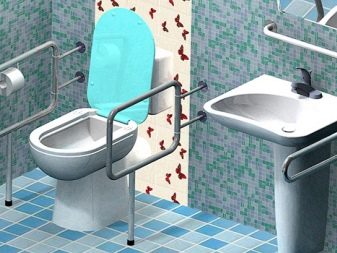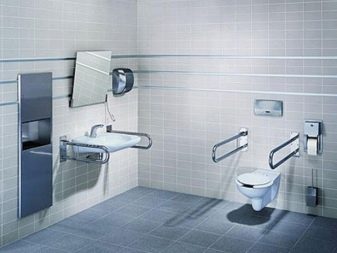Toilet for disabled
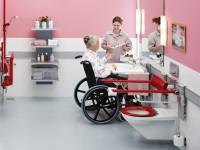
According to the requirements of SNiP, the toilets in public places must have at least one stall equipped for people with disabilities. Unfortunately, this rule is not always enforced, and often disabled people and just elderly people have to experience great inconveniences when using public restrooms. This fact does not speak in favor of the owners and managers of these institutions, because the arrangement of a single stall for the disabled does not require large investments or extensive construction work.
Companies engaged in the production of sanitary ware have long been concerned about the problem of producing sanitary equipment designed for people with limited mobility. To date, there are many models of toilets, sinks and shower cabins on the market of sanitary ware designed specifically for them. In this article, we will tell about the existing toilets for the disabled and how to equip the bathroom for the needs of people with disabilities.
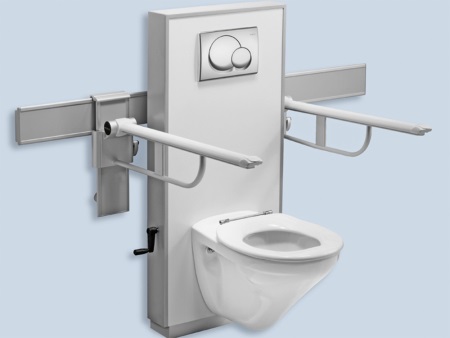
Characteristics of toilets for the disabled with handrails
- The height of the toilet bowl for the disabled, first of all, depends on the height of the person - the bigger it is, the higher the level the toilet bowl should be. This is due to the fact that it is more difficult for a person who is tall, but has limited mobility, to bend his legs and back in order to "adjust" to a standard height toilet bowl. According to the standards, the height of the toilet bowl for the disabled must be between 45 and 60 cm. There are height-adjustable toilet bowls, as well as special racks for raising the height of the toilet bowl by a few centimeters.
- Handrails - This is an obligatory attribute of the bathroom, which will be used by a person with a disease of the musculoskeletal system. It is desirable that all the sanitary devices in the bathroom be equipped with handrails. There are handrails that are mounted directly on the sanitary equipment and handrails that are attached to the floor walls. All handrails are divided into stationary, movable and hinged. Most people give preference to the first type, as they consider them more reliable (it should be noted that other types of handrails, if properly installed by professionals, are absolutely safe). The optimal diameter of the handrail - 4 cm, there are also models with a diameter of 3 and 5 cm.
- Materialswhich are used in the production of toilets for people with disabilities, are standard. In some institutions the equipment is made of anti-vandal materials, but it is not obligatory. The main requirement for the toilet bowls for the disabled is the reliability and stability. Modern toilets made of cast iron, steel and sanitary ware, if they are installed in compliance with all recommendations, quite meet these requirements.
- The seat and lid - are some of the most important parts of the toilet bowl for the disabled. Special attention should be paid to the choice of these elements. However, if the damage to the musculoskeletal system is not very strong, you can be limited to the standard accessories that are used for conventional toilets. The toilet seat extensions for the disabled can be adjusted in height and width. Some models are equipped with automated features such as microlift or heating. There are covers equipped with a motion sensor that lifts when a person approaches.
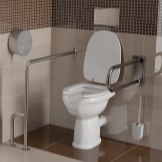
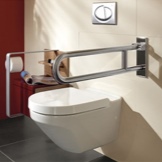
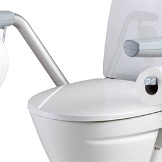
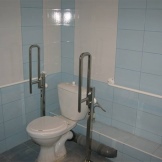
Special lids
If buying a special toilet bowl for people with disabilities is not possible, for example, for financial reasons, or lack of space in the bathroom, consider the alternative option, which is the lining on the toilet. It is a seat that is installed on a regular toilet bowl. It is equipped with handrails and has a high seat. Such a pad is easy to install and easy to remove. So if there is a disabled or elderly person living in the family who has difficulty moving, he can safely use a common toilet bowl.
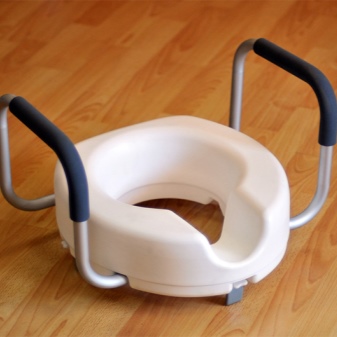
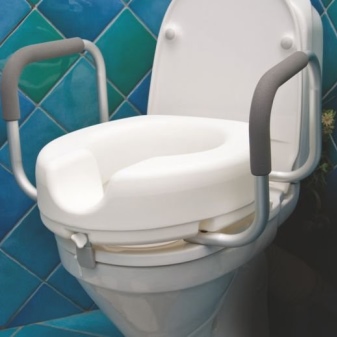
The toilet lid for the disabled is often made according to individual parameters, taking into account all the wishes of the customer. This is much easier than making a whole toilet bowl to order.
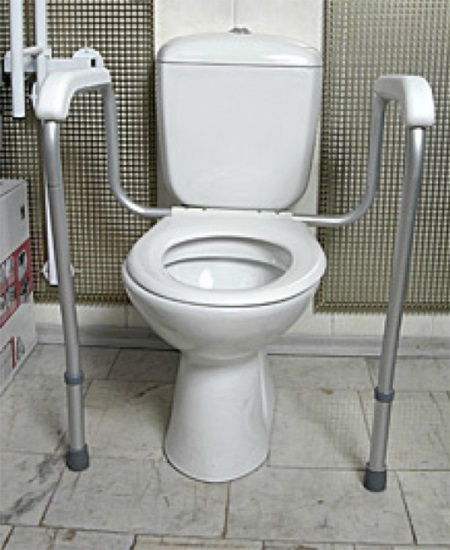
Installation
Handrails must be installed according to the following instructions:
- Before buying handrails, take the necessary measurements, decide on their number, size and location.
- While being in a store check the set of chosen goods, if necessary buy the necessary fixings and accessories (the additional accessories include, for example, rubber or polyurethane covers on handrails, which make their use more comfortable).
- Prepare a place to work. Draw a marking on the floor and walls, mark the places of future fasteners.
- Next, using a hole punch, drill all the necessary holes. Their sizes depend on the fasteners included with the handrails (so the diameter and depth of the holes are usually specified in the installation instructions).
- The next step is to install and fix the handrails. Remember that the reliability of fasteners - the main condition for the safety and comfort of the one who will use the toilet, so at this stage be especially careful.
- The last step is to install the plates, plugs and other additional accessories.

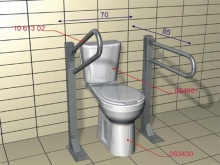
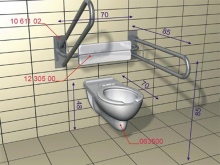
Installation of the installation involves the following sequence of steps:
- First of all, it is necessary to make measurements. It is desirable that the person who will use the toilet should be involved in this. The height of the structure must be such that the user can freely move from the wheelchair to the toilet seat.
- According to the measurements, make a marking on the wall.
- Next, depending on the position of the drain, marked a place on the floor, where the installation will be mounted.
- In accordance with the drawn markings you need to drill holes and fix dowels in them.
- The next step is to install the installation. It is fixed to the dowels with the nuts and screws provided. Fixing the body of the installation, you should align it horizontally and vertically. For this purpose, the structure is equipped with special adjusting feet.
Thus, equipping the bathroom for a person with limited mobility - a task, although not easy, but quite doable. The main thing is to take into account the needs of the person for whom you are trying, as well as choose high-quality and reliable equipment. With a little effort, you will be able to provide a special person in your family with a comfortable living environment.
